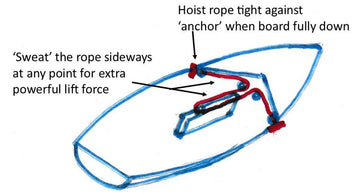- Grippy Gloves: Rubberised gardening gloves (usually yellow) are cheap, give excellent grip and last well – except that where you cut off the top of the finger and thumb, the cotton material frays badly. Using a lighter (as one would to seal a fraying synthetic rope) doesn’t work. The trick is to seal the severed edges generously with rubber glue such as Evo-stick.
- Drying out the buoyancy tank by climbing under the foredeck and reaching into the buoyancy tank with a sponge is awkward to say the least. Keep a sponge permanently whipped or taped onto the end of a tough piece of wire, such as a coat-hanger, perhaps two feet long and bent into a curve. It makes the job much easier.If there is only a drain hole such as on a Laser, a small strip of towelling taped to a bent piece of wire will reach that pesky last half cup-full. The towelling can be left trailing out of the hole to ‘syphon’the last of the water out.
- In winter, don’t leave water in the mast step of a Laser – if it freezes, there is a danger of cracking the fibreglass. Have a sponge on a short length of rope and a stick (to poke it in with), to dry it when putting the boat away.
- The bane of winter sailing is painfully cold hands. A couple of tips to help minimise the cold:a)Keep your sailing gloves warm and dry in your buoyancy jacket pocket while you launch, wearing instead a pair of sturdy washing-up gloves. Once finished lowering the rudder blade etc., swap to the dry gloves. b)If there is a second race after coming ashore, have a second, dry pair of sailing gloves available so that step 1 works again.
- A pivoting centreboard when in the fully down position can be very difficult to hoist up, even with 2 to 1 tackle. However, if the tackle is stopped off with ‘anchor’ knots so that it is just getting tight when the board is fully down, the hoist can be ‘sweated’ sideways at almost any point along its length, giving a much more powerful pull than can be achieved simply by pulling on the hoist.
 The idea works just as well, possibly better, with a continuous up and down system. The ‘anchor’ point must be chosen carefully, perhaps at the eye through a bulkhead
The idea works just as well, possibly better, with a continuous up and down system. The ‘anchor’ point must be chosen carefully, perhaps at the eye through a bulkhead 

Competition entry #7: 5 Expert Level Tips from a Sailing Enthusiast
Rob knows what he's talking about, submitting 5 ideas he's discovered in sailing:











 Select Store
Select Store
 US
US
 UK
UK
